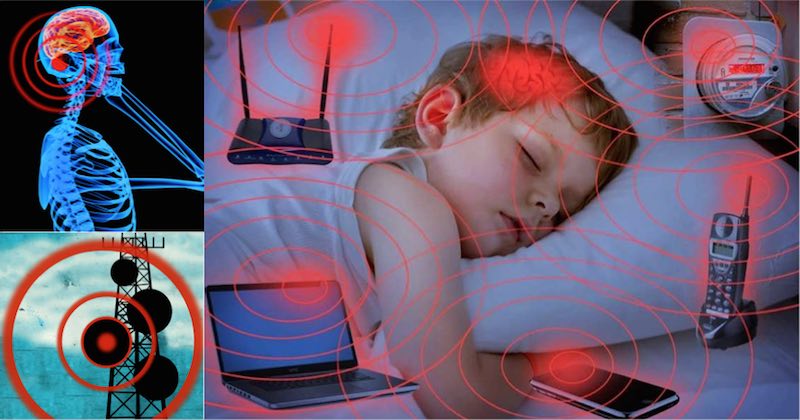The radiation RF-EMF causes damage to DNA, increase the temperature of tissues and even disrupt the blood brain barrier. These effects are real, and ARPANSA is actively involved within the EHS communities, medical professionals, and researchers. ARPANSA will continue study research related to the health effects caused by EMF radiation.
RF-EMF damages DNA
Exposed to man-made electromagnetic fields (EMFs) are associated with DNA damage as well as adverse health effects. EMFs can affect intracellular ionic concentrations, which are vital to maintain a cell's electrochemical balance. It can also alter the balance of cell metabolism, resulting damages to the DNA. Moreover exposure to EMFs can cause the production of free radicals and reactive oxygen species (ROS).
The exposure to radiation from RF-EMF has been associated with changes in the development of male germ cells. This results in the transformation of germ cells into spermatozoa as well as functional maturation as the spermatozoa pass throughout the epididymis. To determine the effects of RF-EMF on the development of male germ cells, a specially-built waveguide device was developed to expose mice that were not restrained to RF-EME in the range of 2.2 W/kg.
In a recent study, researchers discovered that exposure to RF-EME causes oxidative DNA damage in the spermatozoa. Sperm DNA fragmentation was increased by 18% after one week of treatment and by 23 percent after five weeks. Furthermore, DNA damage in mitochondria was observed by measuring the level of a biomarker, 8-hydroxy-2-deoxyguanosine (8-OH-dG).
However, RF-EMF radiation is not yet classified as a cancer-causing agent. However, numerous studies have revealed that exposure to RF-EMF can affect DNA health in range of cell lines. In one of these studies scientists subjected Vero cells to an EMF at 100 Hz over about 45 minutes. They assessed DNA damage for within 48 hours of exposure to determine if the exposure affected the integrity of DNA.
The RF-EMF effect causes the heating of tissues
While the effects of RF EMF are usually considered to have thermal origins, some studies have shown that non-thermal influences are also evident. These effects may account for some of the unresolved observations in epidemiological studies on EMF hypersensitivity. It is therefore important to take into account non-thermal effects when conducting an exhaustive review.
The non-thermal effects that RF-EMF can have may be mediated by the cell membrane. This is an area which has already been extensively investigated. In is emf radiation harmful , the electrochemical behavior of cell membranes has been investigated. what is emf radiation suggests that energy from RF-EMFs greater than 1 MHz is transferred to the tissue through dielectric and ionic dissipation. Previous theoretical analyses indicated that the energy that is transferred to the tissue could be up to 200 kV/m.
The electric properties of tissues are controlled through the distribution and composition of water molecules and other molecules within the body. This determines how well absorbed EMR RF is by various tissues. Tissues with higher conductivity tend to absorb more field and cause more of an effect. This is why the degree of tissue heating doesn't increase continuously between the outside and inside and is only noticeable in hot spots. Bone and fatty tissue are less susceptible to heating by RF than other tissues because they are not as water-based. content.
The extent of penetration of electromagnetic fields depends on the strength and frequency of field. Muscle tissue is more able to absorb field energies than the other tissue and converts it to heat more effectively. Usually, the depth of penetration that RFEMF has is measured in millimeters (mm). The greater the frequency, the more shallow the penetration.
RF-EMF causes blood-brain barrier disruption
Researchers have found that RF-EMF could disrupt the blood-brain barrier, altering sleep patterns and neurotransmitter levels. Additionally, the effects that EMF in brain activities have been linked to neurodegenerative disorders. For example, EMF from mobile phones could affect the electroencephalogram's activity and sleep patterns, as well as the activities of nitric oxide and xanthin oxidase.
Researchers at the Vienna University have studied the effects of exposure to RF EMF on brain cells. They also examined the effects of ELF EMF on brain system. Though the cellular mechanisms involved are not completely understood however, there is an obvious relationship between exposure to ELF EMF and myelin depletion. This relationship might account for the electro-hypersensitivity symptoms of electro-hypersensitivity. There are, however, known methods for regenerating myelin within the brain.
Researchers have observed that exposure to frequencies of 900 Mhz EMF increased the permeability of BBB and also increased the symptoms of neuronal damage in rodents. They also observed increased extravasation of albumin into neurons. Further, emf radiation found in 30 minutes exposure at 900 MHz 99mTcMIBI increased its penetration to the cerebral cortex. But this effect did not happen with Evans blue injections.
However, RF-EMF does not have a clear method for disrupting the BBB. Evidence suggests that non-thermal EMF exposure can increase erythrocyte membrane permeability. This could influence the BBB and enhance calcium ion efflux. Moreover, the presence of a 99mTc-MIBI radiotracer in the brain is also associated with increased permeability of BBB.

